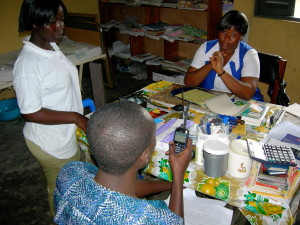At this stage, it is important to map and develop plans and structures that can be activated immediately to contain the spread of Ebola. This includes mapping, building capacity, and developing national and local level assessments, where needed.
Mapping and Coordination
Develop and maintain a map with organograms and an information flow that identifies, geographically and thematically, the government and private and non-governmental organizations to deploy for media communication, SM and health promotion. It is advisable to map the information flows from the national to subnational levels, such as district and community levels. It is also advisable to obtain consensus regarding these maps, organograms and information flows in advance of an outbreak, and keep them updated as needed.
Develop and share standard operating procedures (SOPs) and terms of reference (TORs) for an Ebola communication coordination mechanism that can be implemented easily and defines who does what and when. Consider the integration of SM into other emergency response areas such as case management, contact tracing, quarantine and safe burials, as well as the re-integration of survivors back into the community.
Identify local partners, such as groups or organizations that focus on youth or women; educational, religious and municipal institutions; and other community groups that can disseminate messages at the grassroots level.
Identify credible spokespeople, such as religious leaders, heath care workers and radio or television personalities who can serve as trusted sources of information.
Identify key media, government and health stakeholders who can accurately report on the crisis.
Identify all the channels of communication available to spread the message and assess the reach and credibility of these channels.
Identify hard-to-reach, marginalized populations and prepare a plan to reach out to them in case of emergency.
Consider the need for legal or political decisions, laws and decrees to best manage roles and responsibilities during emergencies.
Consider a physical space for the emergency risk communications team to work as part of the emergency response, such as an emergency communications cell. Identify key personnel, infrastructure, platforms, and logistical and financial resources for this space.
Data and tools
Conduct cultural and social research on the practices of populations within the country to learn about current burial practices, care-seeking behaviors, marginalized populations and other aspects that could affect Ebola containment.
Conduct research to identify and assess the most influential groups and trusted sources of information, including religious and community leaders and others who could have influence on communities.
Identify and assess current state of preparedness assets and create a plan for filling the gaps. Important assets to consider include:
Call center(s)
Mobile technology platforms
Human resources
Economic and equipment resources
Plan for and develop a basic Ebola messaging guide to use in an outbreak, and prepare to adapt and tailor it based on national- and local-level data.
Develop plans for routine monitoring of misinformation and rumors about Ebola, and consider existing technologies to deploy. Also, consider setting up a media monitoring system for keeping track of behaviors and practices related to Ebola.
Training
Identify and train health promotion staff, social mobilizers and volunteers, spokespersons and other high-level staff in SBCC and crisis communication. Training could include:
Community engagement approaches including two-way communication and integration of communication into an Ebola emergency response (e.g., case management, quarantines, safe and dignified burials, etc.)
Developing Ebola materials and messages
Conducting rapid assessments, rapid implementation and monitoring
Technologies that would help with message dissemination or data collection
Consider other training possibilities, such as youth awareness workshops, community-based volunteer/training of trainer (TOT) workshops, and trainings for community leaders on the management of community-based Ebola responses.
Consider briefing and training media so that they are well informed and familiar with key experts and officials who can explain and speak about the emergency.

